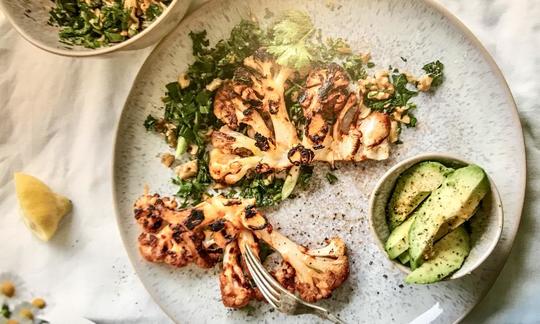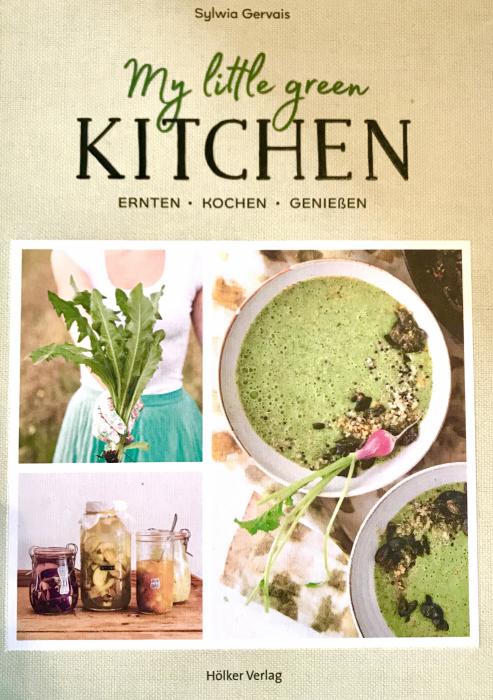Cauliflower steaks with harissa, walnuts and parsley
vegan
Ingredients (for servings, )
| For the cauliflower steaks | |
|---|---|
| 1 | Cauliflower, raw (organic?) (21 oz) |
| 1 clove | Garlic (organic?) (0.11 oz) |
| For the harissa paste | |
| 1 tsp | Paprika powder, sweet (raw?, organic?) (0.08 oz) |
| 1 tsp | Cumin, ground (raw, organic?) (0.11 oz) |
| 1 tsp, ground | Real coriander, seeds (raw?, organic?) (0.08 oz) |
| ½ tsp | Paprika powder, hot (raw?, organic?) (0.04 oz) |
| ¼ tsp | Cayenne pepper (raw?, organic?) (0.02 oz) |
| 2 tbsp | Drinking water, raw (organic?) (0.40 oz) |
| addition to the harissa glaze | |
| 1 tbsp | Maple syrup (organic?, raw?) (0.70 oz) |
| 2 tbsp | Drinking water, raw (organic?) (0.40 oz) |
| For the herbal mixture | |
| 1 tbsp | Sesame, raw, unpeeled (sesame seeds, organic?) (0.32 oz) |
| 1 ¾ oz | Walnuts (tree nuts), raw (organic?) |
| ½ bunch | Parsley, fresh, raw (leaf parsley, parsley) (0.53 oz) |
| ½ bunch | Coriander leaves, raw (0.35 oz) |
| ½ tbsp | Linseed oil (linseed oil, flax oil), cold pressed (raw?, organic?) (0.24 oz) |
| 1 tbsp | Lemon juice (raw?, organic?) (0.26 oz) |
| 1 dash | Table salt (table salt, raw?, organic?) (0.01 oz) |
Equipment
- garlic press
- skillet (frying pan)
- stove
- citrus juicer (lemon squeezer)
- oven
- baking sheet (cookie sheet)
Type of preparation
- cook
- fry
- bake
- chop or grind
- squeeze
- dry roast
- remove the skin
Preparation
For the cauliflower steaks
Clean the cauliflower and cut it into 1 cm wide slices. Since not all of the florets will stick to the stalk, you will also get loose pieces. Peel the garlic clove and press it through the garlic press.Cover the bottom of a large pan with water to a depth of about 1 cm. Add the garlic and bring the water to a simmer. Briefly cook the cauliflower pieces on both sides until al dente and preheat the oven to 200 °C.
For the harissa paste
Mix the ingredients for the harissa paste. Mix together with maple syrup and water in a bowl to make a glaze. Brush the cauliflower slices on both sides with the harissa glaze and place on a baking tray lined with baking paper.The original recipe uses smoked paprika powder - a good example is Pimentón de la Vera.
Alternatively, you can use ready-made harissa paste (as indicated in the recipe) and simply mix it with maple syrup and water.
Bake the steaks for 7-8 minutes. Then increase the temperature to 240 °C and let the steaks crisp up for another 2 minutes.
For the herbal mixture
Briefly roast the sesame seeds in a pan without fat, making sure they don't burn. Remove the seeds and then roast the walnuts in the same pan. Rinse the parsley and coriander, pat dry and chop finely.Mix the herbs, nuts and sesame seeds in a bowl with linseed oil and lemon juice and season with salt.
Serve with the cauliflower steaks.
|
Nutritional Information per person
Convert per 100g
|
2000 kcal | |
|---|---|---|
| Energy | 228 kcal | 11.4% |
| Fat/Lipids | 16 g | 22.6% |
| Saturated Fats | 1.8 g | 8.8% |
| Carbohydrates (inc.dietary fiber) | 20 g | 7.3% |
| Sugars | 8.7 g | 9.7% |
| Fiber | 6.5 g | 25.8% |
| Protein/Albumin | 7.6 g | 15.2% |
| Cooking Salt (Na:119.3 mg) | 303 mg | 12.6% |
| Essential micronutrients with the highest proportions | per person | 2000 kcal | |
|---|---|---|---|
| Fat | Alpha-Linolenic acid; ALA; 18:3 omega-3 | 2.8 g | 139.0% |
| Vit | Vitamin C (ascorbic acid) | 104 mg | 130.0% |
| Vit | Vitamin K | 65 µg | 86.0% |
| Fat | Linoleic acid; LA; 18:2 omega-6 | 7.5 g | 75.0% |
| Vit | Vitamin B9, B11 (Folate, as the active form of folic acid) | 142 µg | 71.0% |
| Min | Manganese, Mn | 1.2 mg | 62.0% |
| Min | Copper, Cu | 0.51 mg | 51.0% |
| Elem | Potassium, K | 797 mg | 40.0% |
| Vit | Vitamin B6 (pyridoxine) | 0.51 mg | 37.0% |
| Prot | Tryptophan (Trp, W) | 0.08 g | 34.0% |
Detailed Nutritional Information per Person for this Recipe
The majority of the nutritional information comes from the USDA (US Department of Agriculture). This means that the information for natural products is often incomplete or only given within broader categories, whereas in most cases products made from these have more complete information displayed.
If we take flaxseed, for example, the important essential amino acid ALA (omega-3) is only included in an overarching category whereas for flaxseed oil ALA is listed specifically. In time, we will be able to change this, but it will require a lot of work. An “i” appears behind ingredients that have been adjusted and an explanation appears when you hover over this symbol.
For Erb Muesli, the original calculations resulted in 48 % of the daily requirement of ALA — but with the correction, we see that the muesli actually covers >100 % of the necessary recommendation for the omega-3 fatty acid ALA. Our goal is to eventually be able to compare the nutritional value of our recipes with those that are used in conventional western lifestyles.
| Essential fatty acids | per person | 2000 kcal |
|---|---|---|
| Alpha-Linolenic acid; ALA; 18:3 omega-3 | 2.8 g | 139.0% |
| Linoleic acid; LA; 18:2 omega-6 | 7.5 g | 75.0% |
| Essential amino acids | per person | 2000 kcal |
|---|---|---|
| Tryptophan (Trp, W) | 0.08 g | 34.0% |
| Threonine (Thr, T, irreversibly transaminated) | 0.28 g | 30.0% |
| Lysine (Lys, K, irreversibly transaminated) | 0.53 g | 29.0% |
| Valin (Val, V) | 0.42 g | 26.0% |
| Isoleucine (Ile, I) | 0.28 g | 23.0% |
| Leucine (Leu, L) | 0.47 g | 19.0% |
| Phenylalanine (Phe, F) | 0.29 g | 19.0% |
| Methionine (Met, M) | 0.10 g | 11.0% |
| Vitamins | per person | 2000 kcal |
|---|---|---|
| Vitamin C (ascorbic acid) | 104 mg | 130.0% |
| Vitamin K | 65 µg | 86.0% |
| Vitamin B9, B11 (Folate, as the active form of folic acid) | 142 µg | 71.0% |
| Vitamin B6 (pyridoxine) | 0.51 mg | 37.0% |
| Vitamin B5 (Pantothenic acid) | 1.5 mg | 24.0% |
| Vitamin B7 (Biotin, ex vitamin H) | 10 µg | 20.0% |
| Vitamin B1 (Thiamine) | 0.21 mg | 19.0% |
| Vitamin B2 (Riboflavin) | 0.27 mg | 19.0% |
| Vitamin B3 (Niacin) | 1.7 mg | 11.0% |
| Vitamin A, as RAE | 92 µg | 11.0% |
| Vitamin E, as a-TEs | 0.61 mg | 5.0% |
| Essential macroelements (macronutrients) | per person | 2000 kcal |
|---|---|---|
| Potassium, K | 797 mg | 40.0% |
| Phosphorus, P | 182 mg | 26.0% |
| Magnesium, Mg | 80 mg | 21.0% |
| Calcium, Ca | 124 mg | 16.0% |
| Sodium, Na | 119 mg | 15.0% |
| Essential trace elements (micronutrients) | per person | 2000 kcal |
|---|---|---|
| Manganese, Mn | 1.2 mg | 62.0% |
| Copper, Cu | 0.51 mg | 51.0% |
| Iron, Fe | 3.2 mg | 23.0% |
| Zinc, Zn | 1.6 mg | 16.0% |
| Selenium, Se | 3.5 µg | 6.0% |
| Iod, I (Jod, J) | 2.3 µg | 2.0% |
| Fluorine, F | 11 µg | < 0.1% |
My Little Green Kitchen - Harvest. Cook. Enjoy by Sylwia Gervais features classic and creative dishes with a focus on regional and seasonal ingredients.
Since this book is written in German, a description is omitted here. If you are interested, please switch to German in the menu.
The baked cauliflower steaks with harissa are served with a mixture of parsley, coriander, walnuts and sesame seeds.
Serving size: The author has specified the recipe for 3-4 servings.
Nutrient profile: According to GDA guidelines, one portion of this recipe covers over 100% of the average daily requirement of omega-3 fatty acids and vitamin C. It also almost covers the requirement of vitamin K. Folic acid is covered by over 50%. The ratio of omega-6 to omega-3 fatty acids is 3:1, which is below the recommended maximum ratio of 5:1.
However, the cooking process causes the cauliflower to lose some of its nutrients - especially vitamin C. Since the nutrient profile refers to the uncooked ingredients, the values are actually somewhat lower.
Cauliflower: Cauliflower is one of the most easily digestible brassicas. In addition to white, cauliflower is also available in orange, purple and green. It has a high vitamin C content and is also rich in B vitamins and K vitamins.
Walnuts: Of all known nuts, walnuts have the highest content of alpha-linolenic acid (ALA). They also have health benefits thanks to their high levels of tocopherols (forms of vitamin E) and many minerals and trace elements.
Parsley: Parsley comes in a flat form (used here) and a curly form. The fresh parsley herb has a high content of vitamin K, vitamin C and iron.
Coriander: When used raw, green coriander leaves have a lemony-peppery scent and a sour-spicy taste, which some people find unpleasantly soapy.
Sesame: The gluten-free seeds of this pseudocereal contain 50% fats - 44% of which are polyunsaturated fatty acids - and only 18-25% protein. Sesame seeds are one of the foods richest in selenium. They also contain a large amount of calcium. Anyone who is sensitive to sesame should be careful, as it is a very strong allergen.
Linseed oil: Fresh, cold-pressed linseed oil has a slightly distinctive taste, tastes slightly nutty and hay-like. It has a golden yellow color. Cold-pressed linseed oil is a good source of omega-3 fatty acids, but is sensitive to oxidation and can only be stored for a very short time.
Harissa: Harissa is a spicy spice paste that originates from Tunisia. It is traditionally made of chili, cumin, coriander seeds, garlic, salt and olive oil. In this recipe we prepared it as suggested by the author.
What do you have to watch out for as a vegan? You can find more information about the composition of this dish in the nutrient tables under the recipe preparation. You can find information about the optimal ratio of essential fatty acids and general information about common nutritional errors in vegan and raw diets at the following link: Vegans often eat unhealthily. Avoidable nutritional errors .
Coriander (omit): If you don't like coriander, you can simply leave it out. After all, the aversion to coriander is hereditary: researcher Nicholas Eriksson found in a study that the combination of two genes is responsible for some people finding the herb inedible and soapy. If you are preparing a meal for guests, it is therefore advisable to either work without coriander or ask beforehand.




